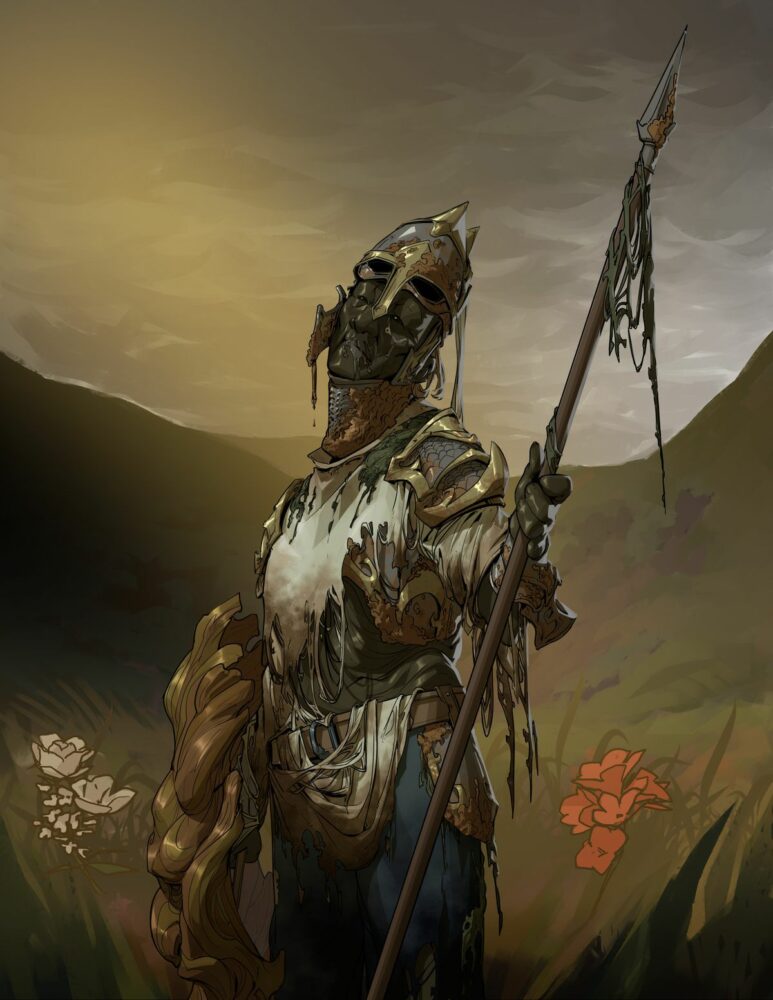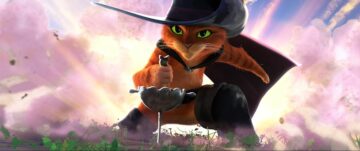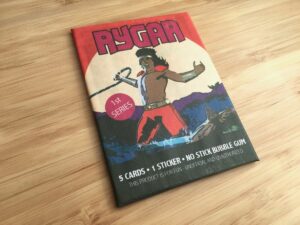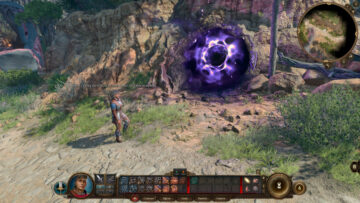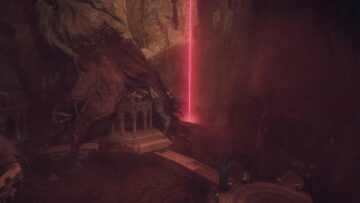Sitting a new player down to their very first game of Dungeons & Dragons, I invariably find myself saying the same thing: “Don’t look at your character sheet. It will just confuse you.” That’s when they usually stare at me like I’ve got a screw loose. We just spent all this time filling that character sheet out, they’re thinking, crafting it into a detailed numerical representation of the powerful person they want to play in-game. Now I’ve taken their totem, their little role-playing life raft, and tossed it into the bin. “Just tell me what you want to do,” I assure them, “and we’ll use your character sheet to support that.”
Legend in the Mist, a rustic fantasy RPG from Son of Oak Game Studio, does things quite a bit differently than D&D. Rather than asking players to fill character sheets with numbers, they ask players to fill them with words — short sentences that represent their characters’ motivations. They call their system “counter-D&D.”
“I am sworn to guard the land and its people,” a standard motivation might say. One that is a little more introspective might be “No one remembers a coward.” It is these simple statements, drawn from a set of carefully crafted and balanced cards — four for each character — that make up the core of each hero present on the table. And it’s from these motivations that all of the game’s mechanical systems are derived.
It’s a profound change in the paradigm of tabletop role-play, a bold and intentional shift, and I think it might be one of the most interesting adaptations to come to TTRPGs in a long, long while.
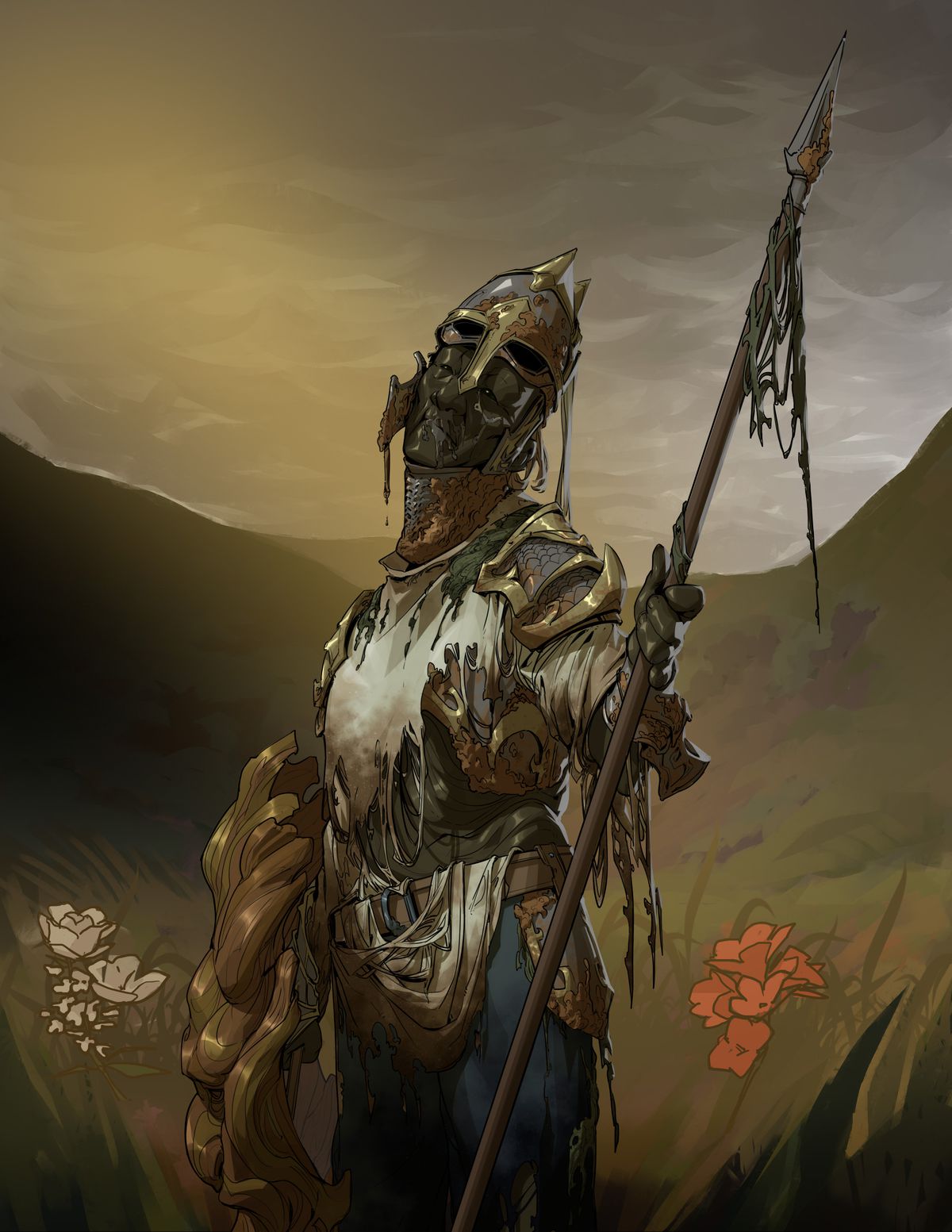
As the undead warrior emerged from the hedgerow, Elliott drew closer despite his terror. The local Red Marshal, Ameena, was moving swiftly to intercept it, her sword raised expertly over her head. With just a few strides she came between it and the village girl, Willow, who had been playing alone in the field. She swung down with a firm chop, but her sword stuck fast in the creature’s flank.
As Elliott watched the Red Marshal struggle to pull the weapon free, a second undead warrior shambled out from behind a hay bale. Elliott dropped the bag of warm apples he’d been picking under the bright autumn sun, knocked a smooth, round stone into his sling and set it to spinning as he carefully backed away into the shadows.
Polygon recently sat down to a demo of the in-development game, led by creative director and studio founder Amit Moshe. He said that while motivations give a character flavor, it’s the character sheet’s many “tags” that players will rely on when they begin rolling dice.
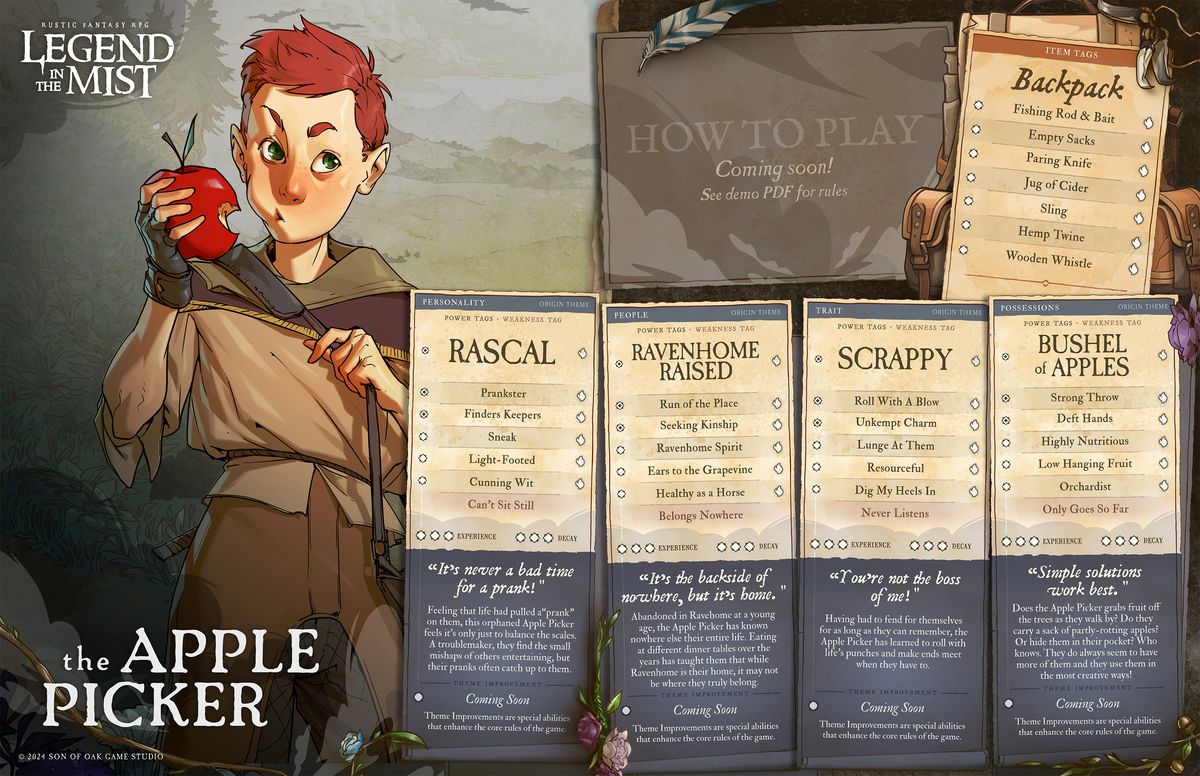
Say that our Elliott, whose character sheet is shown above, wants to help Ameena, the local constable, in a fight with the undead. He’s got a sling and a paring knife, humble weapons to be sure, but Elliott’s real power lies in his motivation for being in the middle of a skirmish in the first place.
Perhaps we imagine Elliott to be a local orphan, a preteen just barely old enough to take care of himself and not nearly wise enough to find his own way in the world. We give him the cards Scrappy and Rascal to represent his place in the world, and Ravenhome Raised to represent his unique relationship to the community that he calls home. Finally, Bushel of Apples sets his appearance apart from his comrades. At the bottom of each of these cards are motivations — sentences that the player can call on in any situation to ground Elliott’s actions in the fiction of the game world.
As Elliott winds up to sling a stone at the undead soldier closing in on him, his player begins to tell a story about how and why he does that. Elliott, ever the prankster, was sneaking around when the undead soldier emerged, and it hasn’t seen him yet. His simple life has given him a strong arm from climbing trees, and nimble fingers from nicking apples and the occasional pie cooling on a Ravenhome windowsill. But he also takes a lot of pride in where he comes from. He looks up to the Red Marshal, and perhaps a shot from his sling will help her to defeat these monsters.
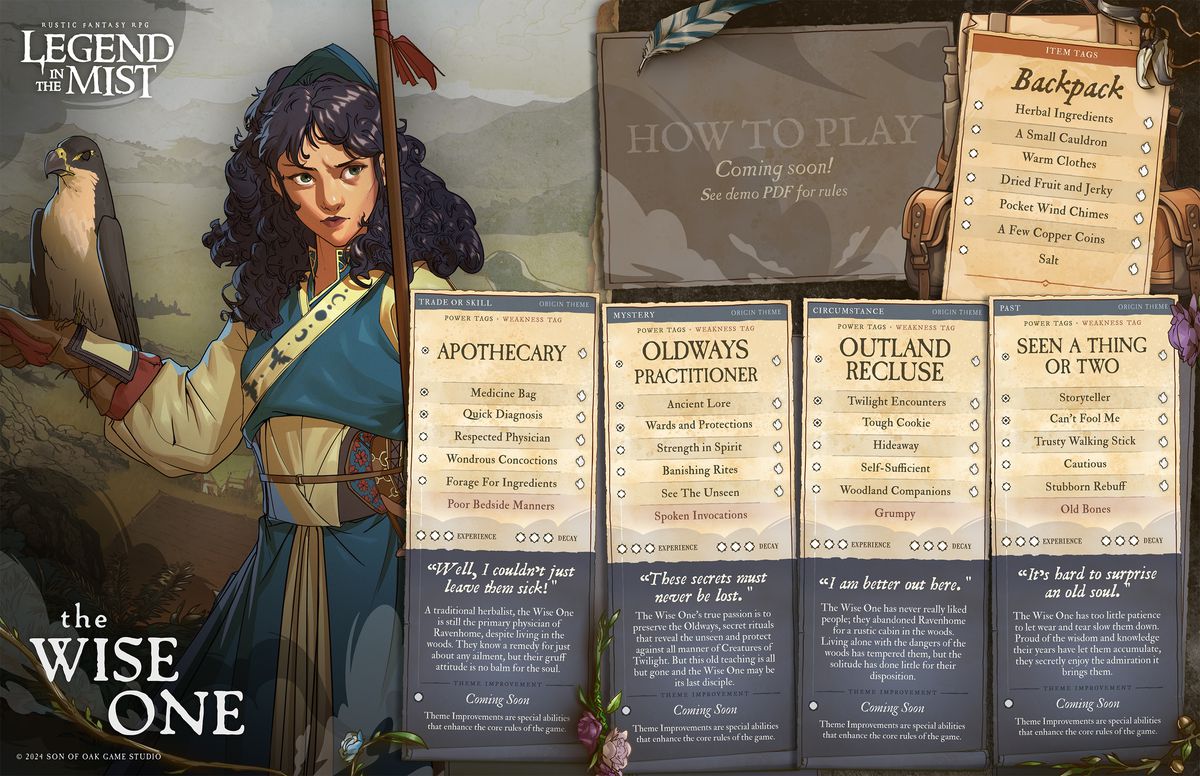
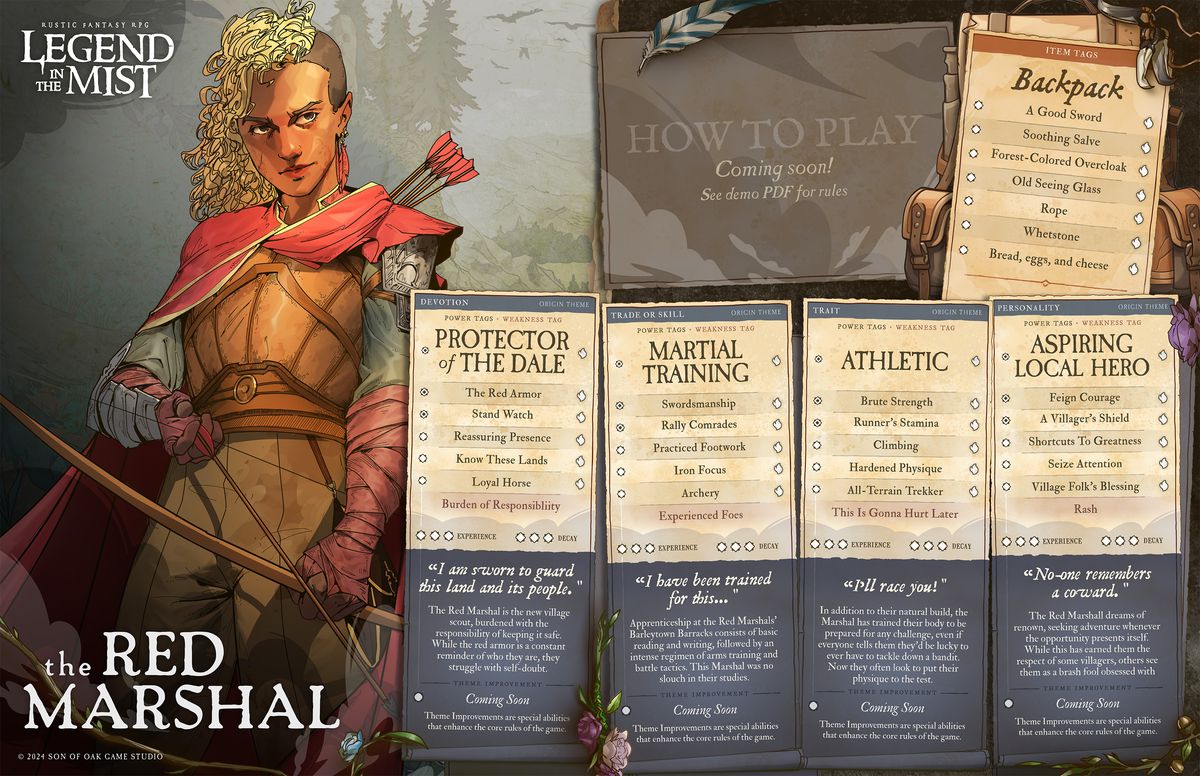
To make this attack, Elliott’s player will roll just a single six-sided die, but to that they’ll add the following: +1 for invoking the Sneak tag, shown on the Rascal card; +1 for his Strong Arm, and another +1 for his Deft Hands, both shown on the Bushel of Apples card; and finally another +1 for Ravenhome Spirit, pulled from his Ravenhome Raised card. That gives Elliott, the party’s smallest and physically weakest character, a mighty +4 as he rears back to cast the stone.
What this system of motivations and tags does for players — especially new players — is keep the character and that character’s reasons for doing what they do at the forefront of their mind. Instead of searching a character sheet for something to do, players instead search the game world for something to feel. That focus on intention creates a wonderful feedback loop, driving the player ever deeper inside the mind of their character and forcing them to see the game world from an unique perspective. The result is a stronger connection between the player and the character, and a delightfully organic way to help the math make sense on the fly.
It also does wonders for character progression.
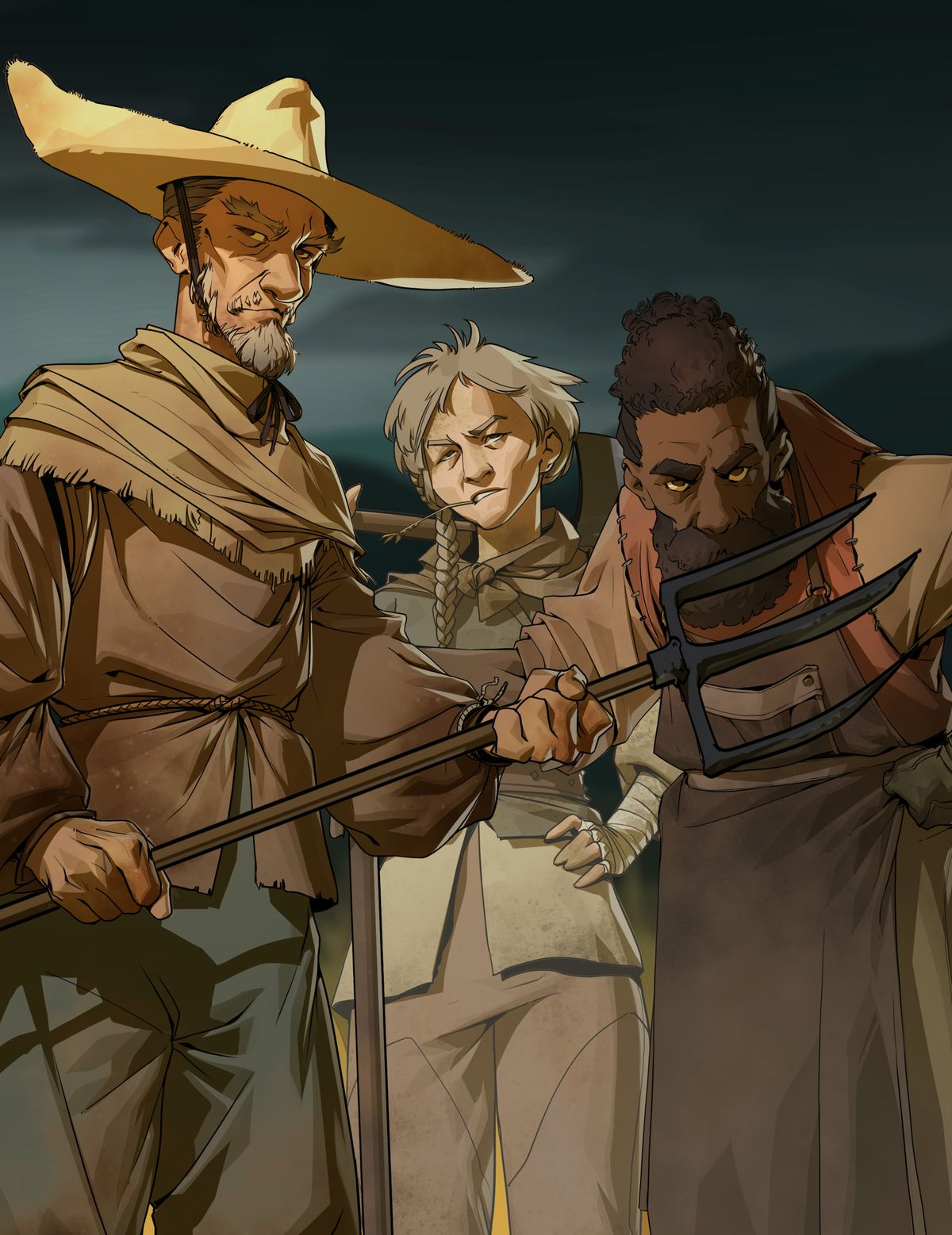
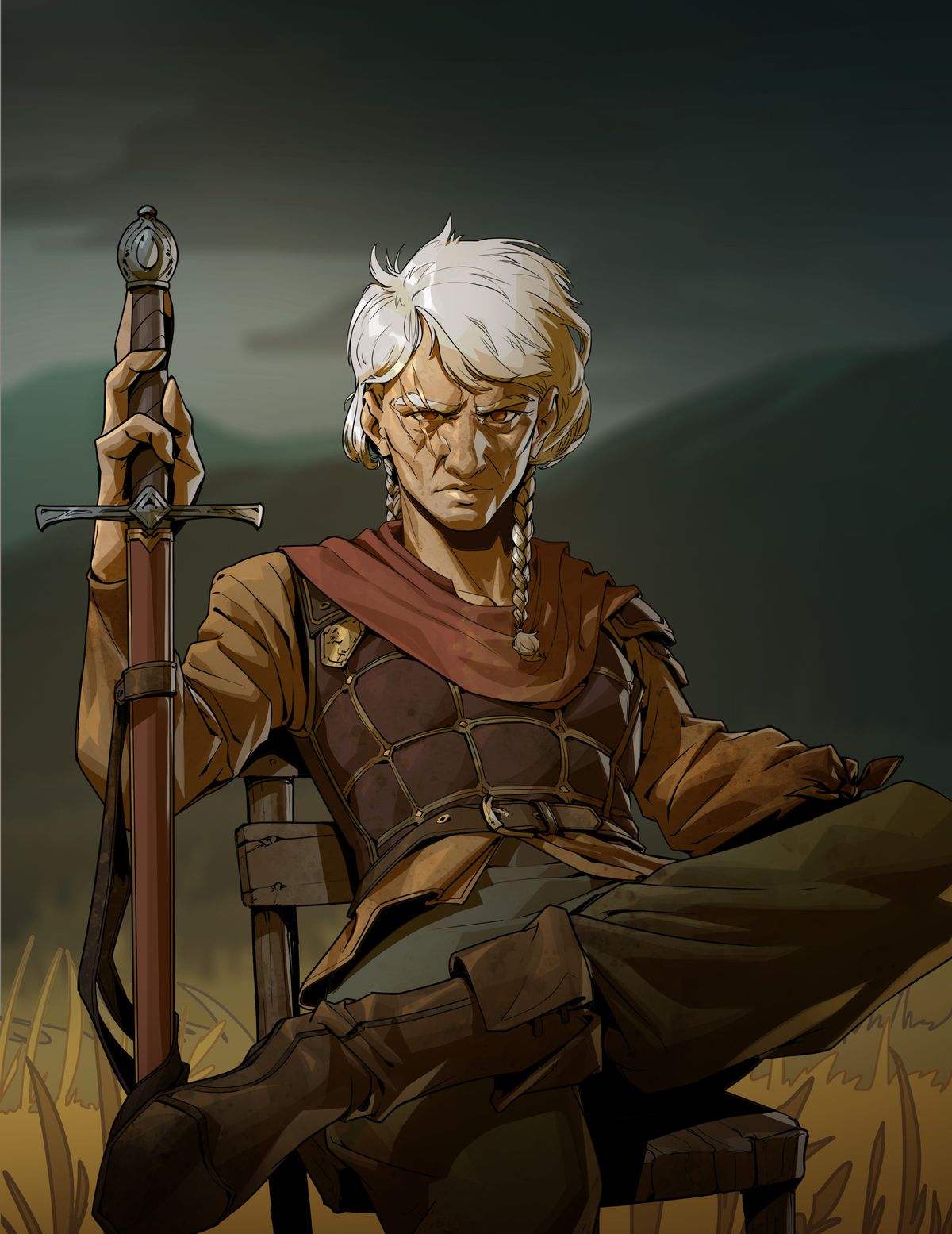
Inside the local tavern, the townsfolk were crowding around Ameena. “What do you mean there was a monster?” “That’s madness. You sound like a fool!” “There haven’t been monsters in these parts for hundreds of years!”
“I saw them with my own eyes, and cut them down with this very sword!” Ameena shouted, trying to fill her voice with as much authority as she could. She had only been a few months on the job and was still trying to make a name for herself inside the small, rural community. “We need to take up arms, form patrols, and make sure our neighbors are safe — especially as night falls.”
Elliott couldn’t believe how the other townsfolk were treating her. Here was the woman who had saved Willow — saved him, too! — and the miller’s wife and the tailor were just dismissing her.
“Ameena was a hero today!” Elliott shouted, leaping on a chair to get noticed, his tiny voice rising above the din. “She stood up to it, she did, and saved Willow and I! Both of us! If you just listen to what she’s saying, she can help keep all of us safe. She can do it again, can’t you, Ameena?!”
The final and most critical part of Legend in the Mist’s card-based, wordy character sheets is a special kind of tag called a weakness. Inside the tavern where the other townsfolk have gathered, Ameena is trying to rally them to stand up a defense. To help out, Elliot is leaning on some of the same tags that helped him out in the fight. But standing among his neighbors, his social status comes into play. To represent that, our game master invokes one of his weaknesses, one that’s right there on his character sheet highlighted in blue — the fact that the tiny orphan doesn’t fit in, that he “Belongs Nowhere,” even the place he deeply loves. Mechanically, that weakness gives Elliott a -1 to the ensuing roll. But if he succeeds at that roll, it could open up a whole world of possibilities.
And that’s because in Legend in the Mist, revealing your characters’ weaknesses is more than just a gambit that spices up the dialogue. When players succeed at a roll where a weakness was invoked, that’s when they earn a point toward leveling up. So it is only by exposing a character’s vulnerabilities that a player can ever hope to change them — maybe with an upgrade or a perk for a beloved motivation card, or maybe by swapping that card out for a different one entirely. In this way, characters don’t so much level up as they evolve into different versions of themselves.
Play Elliott long enough, and the scrappy, fruit-loving rascal might end up being the next Red Marshal of Ravenhome… or someone different entirely.
A digital edition, which includes Legends in the Mist: Core Book and Hearts of Ravensdale – Setting Book, is available for $29. A hardcover version of the Core Book, which also includes PDFs of both the Core Book and the Setting Book, is available for $49. Delivery is expected by June 2025. The crowdfunding campaign for Legend in the Mist runs now through March 7.
Thanks to our playtesters Ash Parrish and Tasha Robinson, who helped bring this game to life. Our game master was Amit Moshe.
- SEO Powered Content & PR Distribution. Get Amplified Today.
- PlatoData.Network Vertical Generative Ai. Empower Yourself. Access Here.
- PlatoAiStream. Web3 Intelligence. Knowledge Amplified. Access Here.
- PlatoESG. Carbon, CleanTech, Energy, Environment, Solar, Waste Management. Access Here.
- PlatoHealth. Biotech and Clinical Trials Intelligence. Access Here.
- Source: https://www.polygon.com/tabletop-games/24059209/legend-in-the-mist-preview-ttrpg-kickstarter-release-date-price
- 2025
- 3000
- 7
- a
- About
- above
- actions
- Adaptations
- add
- again
- All
- alone
- also
- am
- among
- an
- ancient
- and
- Another
- any
- apart
- Apple
- ARE
- ARM
- armed
- arms
- around
- Arrow
- as
- ask
- asking
- assure
- At
- attack
- Authority
- available
- away
- back
- backed
- background
- balanced
- BE
- because
- been
- begin
- begins
- behind
- being
- believe
- beloved
- below
- between
- BIN
- bird
- Bit
- Black
- Blue
- bold
- book
- both
- bottom
- Bright
- bring
- brown
- but
- by
- call
- called
- calls
- came
- Campaign
- CAN
- cape
- card
- Cards
- care
- carefully
- chair
- change
- character
- characters
- Climbing
- closer
- closing
- come
- comes
- community
- connection
- Core
- could
- crafted
- crafting
- creates
- Creative
- critical
- Crowdfunding
- Crowdfunding Campaign
- Cut
- deeper
- deeply
- Defense
- delivery
- Demo
- derived
- despite
- detailed
- dialogue
- DICE
- DID
- die
- different
- differently
- digital
- Dinosaur
- Director
- do
- does
- doing
- down
- drawn
- driving
- dropped
- each
- Earn
- edition
- Elliot
- Elliott
- emerged
- end
- enough
- entirely
- especially
- even
- EVER
- Evolve
- expected
- expertly
- eyes
- fact
- falls
- FANTASY
- FAST
- feedback
- feel
- few
- Fiction
- field
- fight
- filling
- Final
- Finally
- find
- Firm
- First
- first place
- fit
- flavor
- Fly
- Focus
- Following
- For
- forcing
- forefront
- form
- founder
- four
- Free
- from
- full
- game
- Gaming
- gathered
- Get
- give
- given
- gives
- Giving
- got
- Ground
- guard
- had
- Hair
- hands
- has
- hat
- Have
- he
- head
- help
- helped
- her
- here
- Hero
- Highlighted
- him
- himself
- his
- holding
- Home
- hope
- How
- HTTPS
- Humble
- Hundreds
- i
- if
- imagine
- in
- in-game
- includes
- INSIDE
- instead
- intention
- intentional
- interesting
- into
- invariably
- invoked
- Is
- IT
- ITS
- Job
- jpg
- june
- just
- keep
- kickstarter
- kind
- Land
- large
- Led
- let
- Level
- level up
- lies
- Life
- like
- listen
- Little
- local
- Long
- Longsword
- Look
- looks
- lot
- loves
- make
- man
- many
- March
- master
- math
- maybe
- me
- mean
- Middle
- might
- mighty
- mind
- monsters
- months
- more
- most
- motivation
- motivations
- moving
- much
- my
- myself
- name
- nearly
- need
- neighbors
- New
- Next
- Night
- nimble
- not
- now
- nowhere
- numbers
- oak
- of
- Old
- on
- One
- only
- open
- or
- Organic
- Other
- our
- out
- over
- own
- paradigm
- part
- parts
- People
- perhaps
- perk
- person
- perspective
- picking
- place
- plato
- plato data intelligence
- platodata
- platogaming
- play
- player
- players
- Playing
- Point
- Polygon
- possibilities
- power
- powerful
- present
- profound
- progression
- quite
- Raft
- raised
- rally
- rather
- Ready
- Real
- really
- reasons
- recently
- red
- relationship
- rely
- represent
- representation
- result
- revealing
- right
- rising
- Role-Playing
- Roll
- Rolling
- round
- RPG
- Rural
- safe
- Said
- same
- saved
- saw
- say
- saying
- Search
- second
- see
- seen
- sense
- set
- sets
- setting
- several
- she
- sheet
- sheets
- shift
- Short
- shot
- shoulders
- shown
- side
- Simple
- single
- sits
- situation
- small
- smooth
- sneak
- So
- Social
- soft
- some
- someone
- something
- son
- sound
- special
- Spices
- spinning
- spirit
- staff
- stand
- standard
- standing
- stands
- statements
- Status
- still
- Stone
- stood
- Story
- strides
- strong
- stronger
- struggle
- studio
- succeed
- sun
- support
- sure
- swapping
- swiftly
- sword
- system
- Systems
- table
- Tabletop
- tag
- Take
- taken
- takes
- tell
- than
- that
- The
- The Game
- the world
- their
- Them
- themselves
- there
- These
- they
- thin
- thing
- things
- think
- Thinking
- this
- Through
- time
- to
- tossed
- toward
- treating
- trees
- trying
- type
- undead
- under
- unique
- up
- upgrade
- us
- use
- usually
- version
- versions
- very
- Village
- Voice
- Vulnerabilities
- want
- wants
- Warrior
- was
- way
- we
- weakness
- weaknesses
- weapons
- were
- What
- when
- where
- while
- WHO
- whole
- whose
- why
- wife
- will
- winds
- wise
- with
- woman
- words
- world
- yet
- you
- your
- zephyrnet
